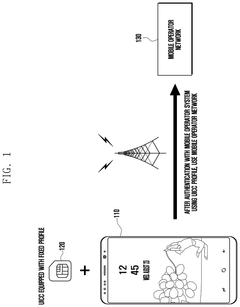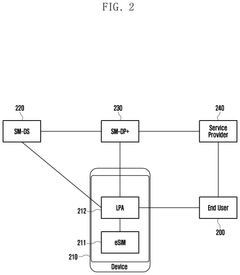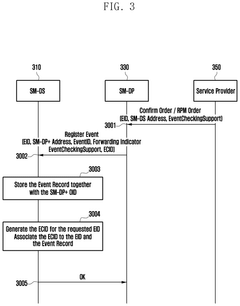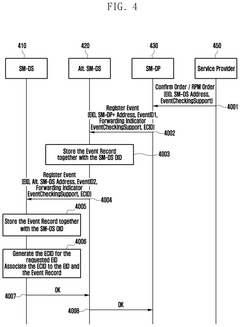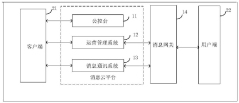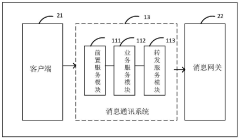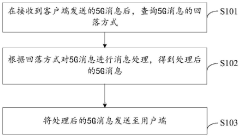How 5G UC Enhances the Efficiency of Global Event Management
JUL 18, 20259 MIN READ
Generate Your Research Report Instantly with AI Agent
Patsnap Eureka helps you evaluate technical feasibility & market potential.
5G UC Background and Objectives
5G Ultra-Capacity (UC) technology represents a significant leap forward in wireless communication, offering unprecedented speeds, ultra-low latency, and massive connectivity. In the context of global event management, 5G UC emerges as a transformative force, poised to revolutionize the way large-scale events are planned, executed, and experienced.
The evolution of mobile networks from 1G to 4G has progressively enhanced communication capabilities, but 5G UC marks a quantum leap. It builds upon the foundation of 5G New Radio (NR) technology, utilizing mid-band spectrum to deliver a perfect balance of coverage and capacity. This technology aims to provide peak data rates of up to 20 Gbps, latency as low as 1 millisecond, and the ability to support up to 1 million connected devices per square kilometer.
The primary objective of integrating 5G UC into global event management is to dramatically improve operational efficiency, enhance attendee experiences, and enable new forms of engagement and interaction. By leveraging the high-speed, low-latency capabilities of 5G UC, event organizers can overcome traditional limitations in connectivity, data processing, and real-time communication that have long plagued large-scale events.
One of the key goals is to create a seamless, hyper-connected environment where all aspects of event management - from ticketing and crowd control to live streaming and interactive experiences - are integrated and optimized. This includes enabling real-time data analytics for crowd management, facilitating high-definition video streaming for remote attendees, and supporting augmented reality (AR) and virtual reality (VR) applications for immersive experiences.
Furthermore, 5G UC aims to enhance security and safety measures at global events. The technology's ability to process vast amounts of data in real-time can significantly improve surveillance systems, emergency response coordination, and overall situational awareness. This is particularly crucial for events that attract large crowds and require complex logistics.
The development of 5G UC technology is driven by the increasing demand for more sophisticated and interactive event experiences. As global events grow in scale and complexity, there is a pressing need for a robust, high-capacity network infrastructure that can support a multitude of simultaneous connections without compromising on speed or reliability.
Looking ahead, the trajectory of 5G UC in event management is expected to lead to the creation of "smart venues" - highly connected, data-driven environments that can adapt in real-time to changing conditions and attendee needs. This vision aligns with broader trends in smart city development and the Internet of Things (IoT), positioning global event management at the forefront of technological innovation.
The evolution of mobile networks from 1G to 4G has progressively enhanced communication capabilities, but 5G UC marks a quantum leap. It builds upon the foundation of 5G New Radio (NR) technology, utilizing mid-band spectrum to deliver a perfect balance of coverage and capacity. This technology aims to provide peak data rates of up to 20 Gbps, latency as low as 1 millisecond, and the ability to support up to 1 million connected devices per square kilometer.
The primary objective of integrating 5G UC into global event management is to dramatically improve operational efficiency, enhance attendee experiences, and enable new forms of engagement and interaction. By leveraging the high-speed, low-latency capabilities of 5G UC, event organizers can overcome traditional limitations in connectivity, data processing, and real-time communication that have long plagued large-scale events.
One of the key goals is to create a seamless, hyper-connected environment where all aspects of event management - from ticketing and crowd control to live streaming and interactive experiences - are integrated and optimized. This includes enabling real-time data analytics for crowd management, facilitating high-definition video streaming for remote attendees, and supporting augmented reality (AR) and virtual reality (VR) applications for immersive experiences.
Furthermore, 5G UC aims to enhance security and safety measures at global events. The technology's ability to process vast amounts of data in real-time can significantly improve surveillance systems, emergency response coordination, and overall situational awareness. This is particularly crucial for events that attract large crowds and require complex logistics.
The development of 5G UC technology is driven by the increasing demand for more sophisticated and interactive event experiences. As global events grow in scale and complexity, there is a pressing need for a robust, high-capacity network infrastructure that can support a multitude of simultaneous connections without compromising on speed or reliability.
Looking ahead, the trajectory of 5G UC in event management is expected to lead to the creation of "smart venues" - highly connected, data-driven environments that can adapt in real-time to changing conditions and attendee needs. This vision aligns with broader trends in smart city development and the Internet of Things (IoT), positioning global event management at the forefront of technological innovation.
Global Event Management Market Analysis
The global event management market has experienced significant growth in recent years, driven by increasing demand for professional event planning services across various industries. This market encompasses a wide range of events, including corporate conferences, trade shows, music festivals, sports events, and weddings. The rise of digital technologies and the increasing importance of experiential marketing have further fueled market expansion.
Market size estimates indicate substantial growth potential for the event management industry. The market is expected to continue its upward trajectory, with a compound annual growth rate (CAGR) projected to remain strong in the coming years. This growth is attributed to several factors, including the globalization of businesses, the need for face-to-face interactions in an increasingly digital world, and the growing importance of events as a marketing and branding tool.
Geographically, North America and Europe have traditionally dominated the global event management market, owing to their mature economies and well-established event infrastructure. However, the Asia-Pacific region is emerging as a significant player, with rapid economic growth and increasing corporate activities driving demand for event management services. Countries like China and India are becoming major hubs for international events and conferences.
The market is characterized by a mix of large multinational corporations and numerous small to medium-sized enterprises. Key players in the industry include global event management companies, specialized event planning firms, and in-house corporate event teams. These organizations offer a range of services, from end-to-end event planning and execution to specific services such as venue selection, logistics management, and on-site coordination.
Technology is playing an increasingly crucial role in shaping the event management landscape. The integration of digital solutions, such as event management software, mobile apps, and virtual event platforms, is enhancing operational efficiency and improving attendee experiences. The COVID-19 pandemic has accelerated the adoption of virtual and hybrid event formats, creating new opportunities and challenges for the industry.
Key trends shaping the global event management market include the growing emphasis on sustainability in event planning, the rise of personalized and immersive experiences, and the increasing use of data analytics to measure event success and ROI. As businesses and organizations recognize the value of well-executed events in achieving their objectives, the demand for professional event management services is expected to continue growing, driving further innovation and competition in the market.
Market size estimates indicate substantial growth potential for the event management industry. The market is expected to continue its upward trajectory, with a compound annual growth rate (CAGR) projected to remain strong in the coming years. This growth is attributed to several factors, including the globalization of businesses, the need for face-to-face interactions in an increasingly digital world, and the growing importance of events as a marketing and branding tool.
Geographically, North America and Europe have traditionally dominated the global event management market, owing to their mature economies and well-established event infrastructure. However, the Asia-Pacific region is emerging as a significant player, with rapid economic growth and increasing corporate activities driving demand for event management services. Countries like China and India are becoming major hubs for international events and conferences.
The market is characterized by a mix of large multinational corporations and numerous small to medium-sized enterprises. Key players in the industry include global event management companies, specialized event planning firms, and in-house corporate event teams. These organizations offer a range of services, from end-to-end event planning and execution to specific services such as venue selection, logistics management, and on-site coordination.
Technology is playing an increasingly crucial role in shaping the event management landscape. The integration of digital solutions, such as event management software, mobile apps, and virtual event platforms, is enhancing operational efficiency and improving attendee experiences. The COVID-19 pandemic has accelerated the adoption of virtual and hybrid event formats, creating new opportunities and challenges for the industry.
Key trends shaping the global event management market include the growing emphasis on sustainability in event planning, the rise of personalized and immersive experiences, and the increasing use of data analytics to measure event success and ROI. As businesses and organizations recognize the value of well-executed events in achieving their objectives, the demand for professional event management services is expected to continue growing, driving further innovation and competition in the market.
5G UC Challenges in Event Management
While 5G UC (Ultra-Capacity) technology offers significant potential for enhancing global event management efficiency, it also presents several challenges that need to be addressed. One of the primary obstacles is the infrastructure requirements for implementing 5G UC networks at event venues. Many existing facilities lack the necessary hardware and connectivity to support high-density, low-latency 5G communications. Upgrading these venues can be costly and time-consuming, potentially disrupting event schedules and operations.
Another challenge lies in the complexity of managing multiple 5G UC-enabled devices and systems simultaneously during large-scale events. The sheer number of connected devices, from attendees' smartphones to event management tools and IoT sensors, can strain network capacity and create potential security vulnerabilities. Ensuring seamless integration and interoperability between various 5G UC-powered applications and legacy systems is crucial but often problematic.
Data privacy and security concerns also pose significant challenges in the context of 5G UC event management. The increased data transmission speeds and lower latency of 5G networks enable real-time collection and analysis of vast amounts of attendee information. However, this raises questions about data ownership, consent, and protection against unauthorized access or breaches. Event organizers must navigate complex regulatory landscapes, such as GDPR in Europe, to ensure compliance while leveraging the benefits of 5G UC technology.
The need for specialized skills and expertise in 5G UC technology presents another hurdle for event management teams. Many organizations lack personnel with the necessary knowledge to effectively deploy, manage, and troubleshoot 5G UC systems in event settings. This skills gap can lead to suboptimal utilization of the technology and potential disruptions during critical moments of an event.
Lastly, the cost factor remains a significant challenge in adopting 5G UC for event management. While the long-term benefits may justify the investment, the initial outlay for equipment, software, and training can be substantial. Smaller event organizers or those operating in regions with limited 5G infrastructure may find it particularly challenging to justify the expense, potentially creating a digital divide in the event management industry.
Addressing these challenges requires a multi-faceted approach involving collaboration between event organizers, technology providers, venue operators, and regulatory bodies. As 5G UC technology continues to evolve, innovative solutions and best practices will emerge to mitigate these obstacles and fully harness the potential of 5G UC in enhancing global event management efficiency.
Another challenge lies in the complexity of managing multiple 5G UC-enabled devices and systems simultaneously during large-scale events. The sheer number of connected devices, from attendees' smartphones to event management tools and IoT sensors, can strain network capacity and create potential security vulnerabilities. Ensuring seamless integration and interoperability between various 5G UC-powered applications and legacy systems is crucial but often problematic.
Data privacy and security concerns also pose significant challenges in the context of 5G UC event management. The increased data transmission speeds and lower latency of 5G networks enable real-time collection and analysis of vast amounts of attendee information. However, this raises questions about data ownership, consent, and protection against unauthorized access or breaches. Event organizers must navigate complex regulatory landscapes, such as GDPR in Europe, to ensure compliance while leveraging the benefits of 5G UC technology.
The need for specialized skills and expertise in 5G UC technology presents another hurdle for event management teams. Many organizations lack personnel with the necessary knowledge to effectively deploy, manage, and troubleshoot 5G UC systems in event settings. This skills gap can lead to suboptimal utilization of the technology and potential disruptions during critical moments of an event.
Lastly, the cost factor remains a significant challenge in adopting 5G UC for event management. While the long-term benefits may justify the investment, the initial outlay for equipment, software, and training can be substantial. Smaller event organizers or those operating in regions with limited 5G infrastructure may find it particularly challenging to justify the expense, potentially creating a digital divide in the event management industry.
Addressing these challenges requires a multi-faceted approach involving collaboration between event organizers, technology providers, venue operators, and regulatory bodies. As 5G UC technology continues to evolve, innovative solutions and best practices will emerge to mitigate these obstacles and fully harness the potential of 5G UC in enhancing global event management efficiency.
Current 5G UC Event Solutions
01 Network resource allocation and optimization
5G UC efficiency can be improved through intelligent allocation and optimization of network resources. This includes dynamic spectrum management, adaptive beamforming, and load balancing techniques to maximize capacity and minimize interference. Advanced algorithms are employed to optimize resource utilization based on real-time network conditions and user demands.- Network resource allocation and optimization: 5G UC efficiency can be improved through intelligent allocation and optimization of network resources. This includes dynamic spectrum sharing, adaptive beamforming, and advanced scheduling algorithms to maximize capacity and minimize latency. These techniques allow for more efficient use of available bandwidth and improved overall network performance.
- Advanced antenna technologies: Implementing advanced antenna technologies such as Massive MIMO (Multiple-Input Multiple-Output) and beamforming can significantly enhance 5G UC efficiency. These technologies enable more focused and directional signal transmission, resulting in improved coverage, capacity, and energy efficiency in ultra-capacity networks.
- Edge computing and network slicing: Integrating edge computing and network slicing capabilities in 5G UC networks can improve efficiency by reducing latency and optimizing resource allocation. Edge computing brings processing closer to the end-user, while network slicing allows for the creation of virtual, customized network segments tailored to specific use cases and requirements.
- AI and machine learning for network optimization: Leveraging artificial intelligence and machine learning algorithms can enhance 5G UC efficiency through predictive analytics, automated network management, and self-optimizing networks. These technologies enable real-time adjustments to network parameters, traffic routing, and resource allocation based on changing network conditions and user demands.
- Energy-efficient hardware and protocols: Developing and implementing energy-efficient hardware components and communication protocols can improve the overall efficiency of 5G UC networks. This includes low-power radio frequency (RF) components, energy-aware scheduling algorithms, and sleep mode optimizations for network equipment during periods of low activity.
02 Advanced antenna technologies
Implementation of advanced antenna technologies such as Massive MIMO (Multiple-Input Multiple-Output) and beamforming significantly enhances 5G UC efficiency. These technologies enable precise directional transmission, improved signal quality, and increased spectral efficiency, resulting in higher data rates and reduced interference in ultra-capacity networks.Expand Specific Solutions03 Network slicing and virtualization
Network slicing and virtualization techniques are utilized to create multiple logical networks on a shared physical infrastructure. This allows for efficient allocation of resources to different services and use cases, optimizing the overall performance of 5G UC networks. Virtual network functions enable flexible and scalable network management.Expand Specific Solutions04 Edge computing integration
Integration of edge computing with 5G UC networks brings computation and storage resources closer to end-users. This reduces latency, improves response times, and offloads traffic from the core network. Edge computing enhances the efficiency of ultra-capacity networks by enabling real-time processing and localized data management.Expand Specific Solutions05 AI-driven network optimization
Artificial Intelligence (AI) and Machine Learning (ML) algorithms are employed to continuously optimize 5G UC network performance. These technologies enable predictive maintenance, automated network configuration, and intelligent traffic management. AI-driven optimization enhances spectral efficiency, reduces energy consumption, and improves overall network reliability.Expand Specific Solutions
Key 5G UC Providers for Events
The 5G UC (Ultra Capacity) technology for global event management is in a growth phase, with the market expanding rapidly as more organizations recognize its potential to enhance efficiency and connectivity. The global 5G services market is projected to reach significant size in the coming years, driven by increasing demand for high-speed, low-latency communications. Major players like Samsung, T-Mobile, Ericsson, Qualcomm, and Huawei are at the forefront of 5G UC development, with varying levels of technological maturity. These companies are investing heavily in R&D to improve network capabilities, device compatibility, and application-specific solutions for event management, indicating a competitive and evolving landscape.
T-Mobile US, Inc.
Technical Solution: T-Mobile's 5G UC (Ultra Capacity) solution for global event management focuses on leveraging its extensive mid-band spectrum holdings to deliver high-capacity, wide-area coverage. The company's 5G UC network utilizes 2.5 GHz spectrum to provide a balance of speed and coverage, ideal for large-scale events. T-Mobile's approach includes the deployment of Massive MIMO antennas and advanced beamforming techniques to enhance network capacity in densely populated areas. The company's 5G UC network supports average speeds of 300 Mbps, with peak speeds reaching up to 1 Gbps[5]. T-Mobile's solution also incorporates network slicing capabilities, allowing for the prioritization of critical event management traffic. Additionally, the company's partnership with edge computing providers enables low-latency applications for real-time event monitoring and crowd management.
Strengths: Extensive mid-band spectrum holdings, rapid 5G deployment, and strong consumer brand. Weaknesses: May need to strengthen enterprise-focused solutions and international presence for global event management.
Telefonaktiebolaget LM Ericsson
Technical Solution: Ericsson's 5G UC solution for global event management focuses on providing a robust and flexible network infrastructure. Their approach utilizes dynamic spectrum sharing (DSS) technology, allowing seamless transition between 4G and 5G networks to ensure consistent coverage. Ericsson's Private 5G platform offers dedicated network slices for event organizers, providing secure and reliable connectivity. The company's Massive MIMO technology significantly increases network capacity, supporting up to 200 times more devices compared to 4G networks[2]. Ericsson's solution also incorporates advanced analytics and machine learning algorithms to predict and manage network load during peak times, ensuring optimal performance for critical event management applications.
Strengths: Strong presence in global telecom infrastructure, advanced radio technology, and extensive partnerships with major operators. Weaknesses: May face competition in software and services aspects of 5G solutions.
Core 5G UC Event Innovations
Method and apparatus for managing events in a wireless communication system
PatentPendingUS20250184730A1
Innovation
- The proposed method involves a subscription manager discovery service (SM-DS) server performing mutual authentication with a terminal, generating an event checking identifier (ECID) associated with an embedded universal integrated circuit card (eUICC) identifier, and transmitting this ECID to the terminal for storage, allowing efficient event checking and management.
Message cloud platform, communication method and computer readable storage medium
PatentPendingCN117459903A
Innovation
- Provide a message cloud platform, including a public control console, an operation management system and a message communication system. It receives 5G messages sent by the client through the message communication system, processes them, and converts them into information identifiable by the client to achieve Unified management and efficient communication of 5G messages.
5G UC Event Security Measures
The integration of 5G UC technology in global event management brings forth a new era of enhanced security measures. These advanced security protocols leverage the high-speed, low-latency capabilities of 5G networks to create a more robust and responsive security infrastructure.
Real-time video surveillance is significantly improved with 5G UC, allowing for high-definition, lag-free monitoring of event spaces. This enables security personnel to quickly identify and respond to potential threats or incidents. The increased bandwidth also supports the deployment of a greater number of cameras, providing comprehensive coverage of large-scale events.
Biometric authentication systems benefit from the enhanced connectivity, enabling faster and more accurate identity verification at entry points. This reduces queuing times and improves the overall attendee experience while maintaining stringent security standards. The speed of 5G networks allows for real-time cross-referencing with global databases, enhancing the ability to detect and prevent unauthorized access.
IoT-enabled security devices, such as smart sensors and wearables, can be seamlessly integrated into the event security ecosystem. These devices can monitor environmental conditions, track crowd movements, and even detect unusual behavior patterns, all in real-time. The data collected can be instantly analyzed to predict and prevent potential security risks.
5G UC also facilitates improved communication and coordination among security teams. High-quality video conferencing and augmented reality applications enable security personnel to share information and collaborate effectively, even in large and complex event venues. This enhanced situational awareness leads to faster response times and more efficient resource allocation.
Drone technology, powered by 5G networks, offers an additional layer of security. These aerial platforms can provide live aerial surveillance, detect anomalies, and even assist in crowd management. The high-bandwidth capabilities of 5G ensure that the video feeds from drones remain clear and uninterrupted, allowing for continuous monitoring from multiple perspectives.
Artificial Intelligence and Machine Learning algorithms can process vast amounts of data from various security systems in real-time, thanks to the low latency of 5G networks. This enables predictive security measures, where potential threats can be identified and mitigated before they escalate into serious incidents.
In emergency situations, 5G UC supports rapid deployment of crisis management protocols. The network's ability to prioritize critical communications ensures that emergency services can coordinate effectively, even in scenarios where network congestion might otherwise pose challenges.
Real-time video surveillance is significantly improved with 5G UC, allowing for high-definition, lag-free monitoring of event spaces. This enables security personnel to quickly identify and respond to potential threats or incidents. The increased bandwidth also supports the deployment of a greater number of cameras, providing comprehensive coverage of large-scale events.
Biometric authentication systems benefit from the enhanced connectivity, enabling faster and more accurate identity verification at entry points. This reduces queuing times and improves the overall attendee experience while maintaining stringent security standards. The speed of 5G networks allows for real-time cross-referencing with global databases, enhancing the ability to detect and prevent unauthorized access.
IoT-enabled security devices, such as smart sensors and wearables, can be seamlessly integrated into the event security ecosystem. These devices can monitor environmental conditions, track crowd movements, and even detect unusual behavior patterns, all in real-time. The data collected can be instantly analyzed to predict and prevent potential security risks.
5G UC also facilitates improved communication and coordination among security teams. High-quality video conferencing and augmented reality applications enable security personnel to share information and collaborate effectively, even in large and complex event venues. This enhanced situational awareness leads to faster response times and more efficient resource allocation.
Drone technology, powered by 5G networks, offers an additional layer of security. These aerial platforms can provide live aerial surveillance, detect anomalies, and even assist in crowd management. The high-bandwidth capabilities of 5G ensure that the video feeds from drones remain clear and uninterrupted, allowing for continuous monitoring from multiple perspectives.
Artificial Intelligence and Machine Learning algorithms can process vast amounts of data from various security systems in real-time, thanks to the low latency of 5G networks. This enables predictive security measures, where potential threats can be identified and mitigated before they escalate into serious incidents.
In emergency situations, 5G UC supports rapid deployment of crisis management protocols. The network's ability to prioritize critical communications ensures that emergency services can coordinate effectively, even in scenarios where network congestion might otherwise pose challenges.
5G UC Event ROI Assessment
The implementation of 5G UC (Ultra-Capacity) technology in global event management has the potential to significantly enhance efficiency and deliver substantial return on investment (ROI). This assessment examines the key factors contributing to the ROI of 5G UC in event management contexts.
One of the primary benefits of 5G UC is its ability to support high-density connectivity in crowded venues. This capability allows for seamless communication and data transfer among thousands of attendees, staff, and devices simultaneously. The increased network capacity translates to improved event operations, from ticketing and access control to real-time crowd management and security monitoring.
The ultra-low latency of 5G UC enables near-instantaneous data transmission, which is crucial for time-sensitive applications in event management. This feature facilitates real-time analytics, allowing organizers to make data-driven decisions on the fly. For instance, adjusting crowd flow, optimizing resource allocation, or responding to emergencies can be done with minimal delay, enhancing both efficiency and safety.
Enhanced bandwidth provided by 5G UC supports high-quality video streaming and augmented reality (AR) experiences. This capability opens up new revenue streams through virtual attendance options and immersive on-site experiences. Events can reach a global audience without physical limitations, potentially increasing ticket sales and sponsorship opportunities.
The reliability and speed of 5G UC networks also improve the overall attendee experience. Faster internet connections for participants mean smoother social media sharing, easier access to event information, and enhanced interactive elements. This improved experience can lead to higher attendee satisfaction rates, increased likelihood of repeat attendance, and positive word-of-mouth marketing.
From an operational standpoint, 5G UC enables more efficient logistics and supply chain management for events. Real-time tracking of equipment, supplies, and personnel allows for optimized resource allocation and reduced downtime. This efficiency can lead to significant cost savings in large-scale events, directly impacting the bottom line.
The scalability of 5G UC infrastructure means that initial investments can be leveraged across multiple events and venues. As the technology becomes more widespread, the cost of implementation is likely to decrease, further improving the ROI for event organizers adopting this technology early.
In conclusion, the ROI assessment for 5G UC in global event management reveals multiple avenues for increased efficiency, enhanced attendee experiences, and new revenue opportunities. While initial implementation costs may be significant, the long-term benefits and competitive advantage offered by this technology make it a compelling investment for forward-thinking event organizers.
One of the primary benefits of 5G UC is its ability to support high-density connectivity in crowded venues. This capability allows for seamless communication and data transfer among thousands of attendees, staff, and devices simultaneously. The increased network capacity translates to improved event operations, from ticketing and access control to real-time crowd management and security monitoring.
The ultra-low latency of 5G UC enables near-instantaneous data transmission, which is crucial for time-sensitive applications in event management. This feature facilitates real-time analytics, allowing organizers to make data-driven decisions on the fly. For instance, adjusting crowd flow, optimizing resource allocation, or responding to emergencies can be done with minimal delay, enhancing both efficiency and safety.
Enhanced bandwidth provided by 5G UC supports high-quality video streaming and augmented reality (AR) experiences. This capability opens up new revenue streams through virtual attendance options and immersive on-site experiences. Events can reach a global audience without physical limitations, potentially increasing ticket sales and sponsorship opportunities.
The reliability and speed of 5G UC networks also improve the overall attendee experience. Faster internet connections for participants mean smoother social media sharing, easier access to event information, and enhanced interactive elements. This improved experience can lead to higher attendee satisfaction rates, increased likelihood of repeat attendance, and positive word-of-mouth marketing.
From an operational standpoint, 5G UC enables more efficient logistics and supply chain management for events. Real-time tracking of equipment, supplies, and personnel allows for optimized resource allocation and reduced downtime. This efficiency can lead to significant cost savings in large-scale events, directly impacting the bottom line.
The scalability of 5G UC infrastructure means that initial investments can be leveraged across multiple events and venues. As the technology becomes more widespread, the cost of implementation is likely to decrease, further improving the ROI for event organizers adopting this technology early.
In conclusion, the ROI assessment for 5G UC in global event management reveals multiple avenues for increased efficiency, enhanced attendee experiences, and new revenue opportunities. While initial implementation costs may be significant, the long-term benefits and competitive advantage offered by this technology make it a compelling investment for forward-thinking event organizers.
Unlock deeper insights with Patsnap Eureka Quick Research — get a full tech report to explore trends and direct your research. Try now!
Generate Your Research Report Instantly with AI Agent
Supercharge your innovation with Patsnap Eureka AI Agent Platform!
